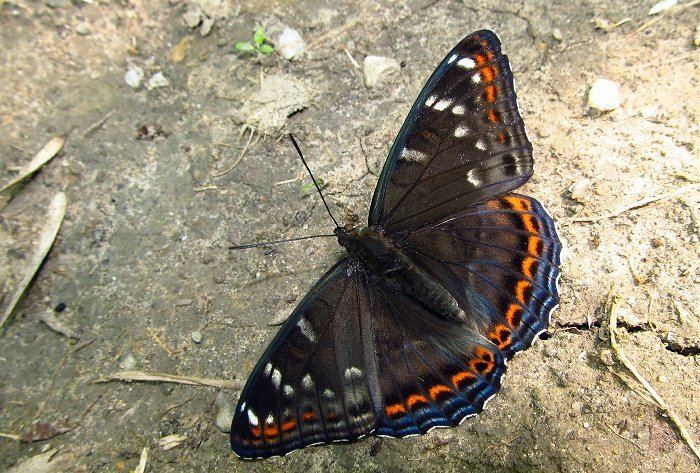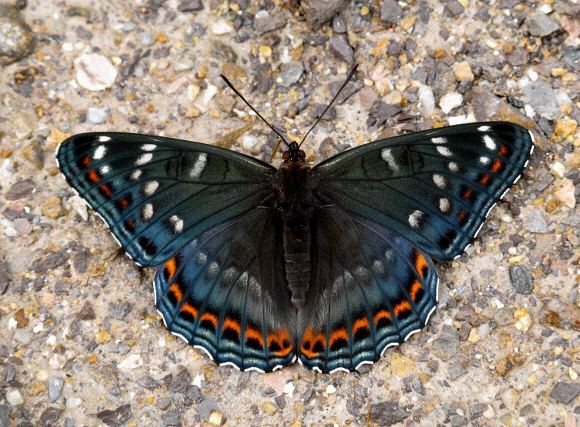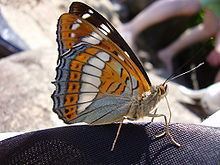Higher classification Limenitis | Scientific name Limenitis populi Rank Species | |
 | ||
Similar Limenitis, Butterflies and moths, Butterfly, Limenitis camilla, Erebia ligea | ||
Poplar admiral feeding
The poplar admiral (Limenitis populi) is a butterfly in the heliconiine subfamily of the Nymphalidae family.
Contents
- Poplar admiral feeding
- Poplar admiral butterfly
- Habitat
- Characteristics
- Behavior
- Metamorphosis
- Egg
- Caterpillar
- Adult
- Distribution
- Conservation
- Subspecies
- References
Poplar admiral butterfly
Habitat

Poplar admiral habitat is widespread in continental Europe and many areas in Asia. The large, seldom-seen poplar admiral is one of the biggest butterflies in Europe. It is found in deciduous forests, where aspen (Populus tremula) or black poplar (Populus nigra) trees grow. This is because the caterpillar only eats the leaves of these species. At altitude, for instance in the Alps, where there are not large Populus forests, they accommodate with a grove, in the southeast of France they can be seen flying in large open spaces, for instance in the department of Alpes-Maritimes, as noted by Jacques Rigout. The males are easier to find. The females are rarer, because they tend to stay in the tops of the trees and seldom venture to the ground.
Characteristics

The wingspan in spread specimens varies for the males from 66 to 77 mm, and for the females from 82 to 85 mm, all measures done on the larger private collection of Limenitis populi, now in the hands of Jean-Claude Weiss, a specialist of Parnassius. In fact, specimens in the field are relatively of the same size; the differences are mainly because of variations among subspecies, not variations at one location. There are some specimens that are very small, about half the usual size, but they have been specifically bred. There is a noticeable difference in size between sexes. The females have distinct broad white lines over their back wings. On the males the lines are narrower and fainter, and sometimes are not there at all. The upper surface is dark brown with white spots. The white stripe is surrounded by orange and blue borders. The underside is orange.
Behavior
They are attracted to foul smells, such as those given off by carrion or dung. The butterflies use their proboscis to draw important minerals from the sap of trees, from the ground or from sweat. They do not visit flowers.
Metamorphosis
The butterflies feed on aspens, and occasionally also black poplars in warm, wind-free locations. It is there that they lay their green eggs on the top side of the leaves.
Egg
Many errors in the literature still persist, such as Eugen Niculescu who described the egg as having ribs. In fact, the egg is covered with hollow polygons. The duration of the egg stage is 7 days, not 14 as E. Niculescu writes (l.c.).
Caterpillar
Georg Dorfmeister was the first to describe and measure the caterpillar and chrysalid.
Ekkehard Friedrich clearly described the early stages of the young larva.
In Europe, the caterpillars feed on Populus tremula and P. nigra (not on P. alba). In Japan, they eat Populus maximowiczii (Tabuchi), and the Japanese subspecies even accept many varieties of willow (Salix sp.) in captivity. In August the caterpillars, which are still quite small, make a cocoon from a leaf that they cut out and roll up. They spend the winter in this cocoon and then emerge from it before the leaves come out in the spring.
The green caterpillar has black and brown shades. Its head is reddish brown, and its sides are black. First it eats the leaf buds, then the new leaves. Pupation takes place in June in a leaf that is lightly spun together.
Adult
As a general rule, hatching occurs from the third week of June to mid-July, although some have been known to leave as early as May (which is often the case in Japan). In France the record dates of the flight period is from 30 May (in 1971) to 16 August (in 1974).
Male are seen first; the females stay at the top of the trees and are sometimes found on the ground about two weeks later, only in the morning, often when the males are no longer seen. Male flight can be very fast, the female flight is quite slow, somewhat like a glider.
Distribution
The species is known to occur in western Europe from Denmark to northern Italy (the Spanish record noted by Miguel-Angel Gomez Bustillo is doubtful), then Germany to Greece, Russia to Japan including China. Jacques Rigout has published precise distribution maps in France of this butterfly. The study was done by listing the data from the specimens preserved in the Paris Museum and the British Museum and captures done by the French entomologists.
Conservation
The now rare poplar admiral is a protected species. The species is endangered primarily due to the clearing of forests containing the trees that they must feed on to survive, and replacement with more economically valuable conifer forests.
Subspecies
Other names are for aberrations:
